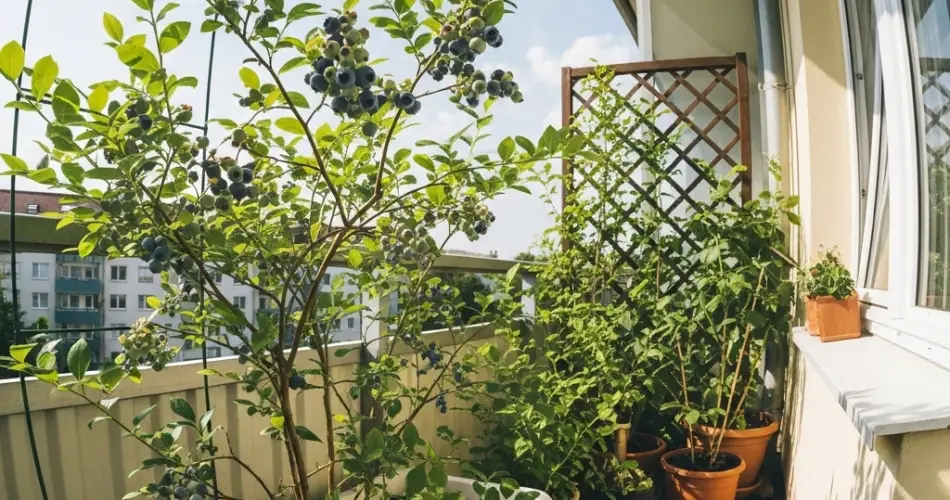Blueberries are not only delicious and nutritious but also highly rewarding to grow at home. If you think you need a large garden to grow these vibrant berries, think again. You can cultivate blueberries right on your balcony, turning a small space into a fruitful mini-orchard. With a bit of care and the right approach, your balcony blueberries will thrive, impressing your neighbors with fresh, juicy berries straight from your own garden.
Here’s a detailed guide to growing blueberries on your balcony successfully, even if you have no prior gardening experience.
Why Grow Blueberries on Your Balcony?
Balcony blueberry gardening offers numerous advantages:
-
Space-saving: Perfect for urban dwellers or anyone without a yard.
-
Fresh and organic: Enjoy pesticide-free, homegrown berries.
-
Decorative: Blueberry bushes have attractive foliage that changes color with the seasons.
-
Health benefits: Blueberries are packed with antioxidants, vitamins, and fiber.
Choosing the Right Blueberry Variety
Selecting the right blueberry variety is crucial for balcony success:
-
Highbush blueberries (Vaccinium corymbosum) are the most common and well-suited for containers.
-
Dwarf varieties: Look for cultivars like ‘Top Hat’, ‘Jelly Bean’, or ‘Peach Sorbet’, which remain compact and are ideal for small spaces.
-
Early vs. late-season varieties: Choose varieties that match your climate and allow for a longer harvesting period.
Planting at least two different varieties improves pollination and fruit yield.
Selecting Containers for Blueberries
Blueberries need containers that accommodate their root system and provide good drainage:
-
Size: Use pots that are at least 12-18 inches deep and wide.
-
Material: Plastic, ceramic, or wooden containers work well, but ensure drainage holes are present.
-
Drainage: Proper drainage prevents root rot, which blueberries are prone to if waterlogged.
Consider using self-watering containers to maintain consistent moisture, especially on sunny balconies.
Preparing the Soil
Blueberries require acidic soil with a pH between 4.5 and 5.5:
-
Use a soil mix designed for acid-loving plants or create your own with peat moss, pine bark, and perlite.
-
Avoid garden soil, as blueberries need well-draining and nutrient-rich soil that doesn’t hold too much water.
-
Adding elemental sulfur can help lower pH if your water or potting mix is too alkaline.
Planting Blueberries on Your Balcony
-
Fill the container: Add your acidic soil mix to the pot, leaving a couple of inches from the rim.
-
Plant your blueberry bush: Gently remove the plant from its nursery pot, loosen the roots slightly, and place it in the container.
-
Fill around the roots: Firm the soil gently around the roots, keeping the crown at soil level.
-
Water thoroughly: After planting, water well to settle the soil and eliminate air pockets.
Caring for Your Balcony Blueberries
-
Watering: Blueberries like consistent moisture but dislike soggy soil. Water when the top inch of soil feels dry.
-
Sunlight: Position your blueberry plants in a spot that gets at least 6 hours of direct sunlight daily.
-
Fertilizing: Use fertilizers formulated for acid-loving plants, such as azalea or rhododendron fertilizers. Feed lightly in early spring and again after harvest.
-
Mulching: Apply a layer of pine needles or wood chips on top of the soil to retain moisture and maintain acidity.
-
Pruning: Prune annually in late winter or early spring to remove dead or weak branches and encourage new growth.
Dealing with Pollination and Pests
-
Blueberries are partially self-pollinating but yield better with cross-pollination. If possible, keep two or more varieties.
-
To attract pollinators, plant companion flowers like lavender or bee balm nearby.
-
Watch for pests such as aphids, spider mites, and birds. Use netting to protect fruit from birds.
-
Organic insecticidal soap or neem oil can help manage pests if they appear.
Harvesting Your Blueberries
Blueberries are ready to harvest when they are fully blue, plump, and easily detach from the stem with a gentle tug.
-
Check your plants regularly during the harvest season, which can last from late spring to summer.
-
Pick berries every few days to encourage more fruit production.
-
Store harvested blueberries in the refrigerator and enjoy them fresh or freeze for later use.
Troubleshooting Common Problems
-
Yellow leaves: May indicate nutrient deficiencies or improper watering.
-
Poor fruit production: Often caused by insufficient sunlight, poor pollination, or over-fertilizing with nitrogen.
-
Root rot: Caused by overwatering or poor drainage; ensure containers drain well and adjust watering frequency.
-
Leaf scorch: In intense sun, some blueberry varieties may develop scorched leaves; provide partial afternoon shade if needed.
Final Thoughts
Growing blueberries on your balcony is a rewarding project that brings both beauty and bounty to your outdoor space. By choosing the right varieties, providing acidic soil, consistent moisture, and plenty of sunlight, you can enjoy delicious blueberries year after year. Plus, the sight of your flourishing blueberry plants will definitely catch the eyes of your neighbors — making them just a little bit jealous of your green thumb!
Start your balcony blueberry garden today, and savor the sweet taste of homegrown success!



